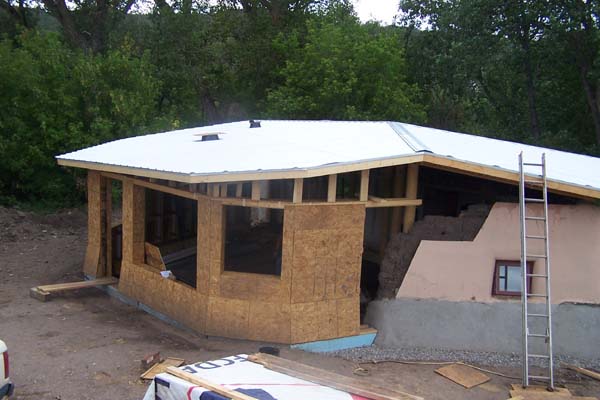An overview of the old small adobe block original home and how it relates to the new add-on progressing along. The size and scope of the new roof with complex angles can be easily seen in this image. Norbert did a great job of connecting the odd shaped 1970’s a400 sq. ft. original adobe home, to the new octagonal shaped add-on.
What can be clearly seen in this image is the adobe back walls of the old structure as they will connect to the new stick framed add-on. Norbert as usual was able to conceive and execute the complex carpentry to bridge the gap. It was then left to Carolyn to add some mud magic in the form of cob to fill in the gaps. Then all that was left was to let the final coats of plaster to connect and secure the old to new.
One detail that might now show much in the photos in this gallery was the flair at the bottom of the new stick framed add-on. It was added with carpentry to mimic the soft flared bottom edge of the old portions of the adobe home. The grey areas shown in the photo (right) surrounding the adobe walls at bottom, are in fact the exterior cement reinforcement we added to secure the building.
As you may have read in other posts, the house was built without a proper foundation. The original builders literally dug a hole to fit the footprint of the home and placed the adobe blocks directly on the ground and began laying the adobe walls upon them. Ah the 1970’s! All might have been well and good, but not long term given the house lays at the base of a watershed. Meaning to those not familiar, that hundreds of gallons of water will rush onto the house during the monsoon season. Norbert dropped the grade of the land surrounding the house, and berms were created to block severe water from draining onto the house. And a rubble trench surrounds the stem wall foundation should any water attempt to reach the house. His efforts have paid off as the house was safe and sound during some torrential downpours which occurred a few years following the completion of the home.


